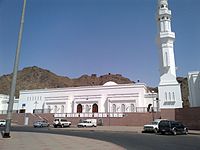
Back سلفية جهادية Arabic السلفيه الجهاديه ARZ সালাফি জিহাদবাদ Bengali/Bangla Jihadisme salafita Catalan سەلەفیی جیھادی CKB Salafismo yihadista Spanish جهادگرایی سلفی Persian Salafisme djihadiste French הג'יהאד הסלפי HE Jihadisme salafi ID
| Part of a series on:
Salafi movement |
|---|
 |
|
|

| Part of a series on |
| Jihadism |
|---|
|
|
Salafi jihadism, also known as revolutionary Salafism[1] or jihadist Salafism, is a religious-political Sunni Islamist ideology that seeks to establish a global caliphate, characterized by the advocacy of "physical" (military) jihadist attacks on non-Muslim targets. The Salafist interpretation of sacred Islamic texts is "in their most literal, traditional sense",[2] which adherents claim will bring about the return to "true Islam".[3][4][5][6][7]
The original use of the term "jihadist Salafists" (also "Salafi-jihadi" or "Salafist jihadis")[3][4][5][8] came from French political scientist Gilles Kepel[9][10][11][12] to refer to international volunteers of the jihad against the Soviet Union in Afghanistan who had come from around the world to fight for Islam against Marxist forces in Afghanistan and had lost the American-Saudi funding and interest after the Soviet forces had withdrawn, but wanted to continue waging jihad elsewhere.[13] Their original jihad was against an aggressive anti-religious power (Soviet Union and its Marxist allies), attempting to take over a Muslim region (Afghanistan), and had been enthusiastically supported by large numbers of Muslims including governments. However, isolated from their national and social class origins and seeking to "rationalize" their "existence and behavior",[9] some Arab Afghan volunteers expanded the targets of their jihad to include the United States (whom they "perceived as the greatest enemy of the faith", despite having supported and armed the Afghan Mujahideen), and various governments of Muslim-majority countries - whom they perceived as apostates from Islam.[2]
Jihadist and Salafist elements of "hybrid" ideology developed by international volunteers ("Arab-Afghan" Mujahideen) had not been joined previously because mainstream Salafis,[3][8][14] (dubbed by some Western commentators as "good Salafis"),[11] had mostly adhered to political quietism - eschewing political activities and partisan allegiances, viewing them as potentially divisive for the broader Muslim community and as a distraction from the studying and practicing of Islam.[15] Prominent Quietist Salafi scholars have denounced doctrines of Salafi jihadism as Bid'ah ("innovation") and "heretical",[16] strongly forbidding Muslims from participating or assisting in any armed underground activity against ruling governments.[Note 1][a] Jihadist salafists often dismiss the quietist scholars as "'sheikist" traitors, portraying them as palace scholars worried about the patronage of "the oil sheiks of the Arabian peninsula" rather than pure Islam,[2] and contend that they are not dividing the Muslim community because, (in their view), the rulers of Muslim-majority countries and other self-proclaimed Muslims they attack are not actually part of the community having deviated from Islam and become apostates or false Muslims.[3][5][19]
Early ideologues of the movement were Arab Afghan veterans of the Afghan jihad: Abu Qatada al-Filistini, the (naturalized Spanish) Syrian Abu Musab, Mustapha Kamel known as Abu Hamza al-Masri, etc.[2] The jihadist ideology of Qutbism has been identified variously as the ideological foundation of the movement,[3][20][21] a closely related Islamist ideology,[3][22][23][24] or a variety of revolutionary Salafism.[3][23] While Salafism had little presence in Europe during the 1980s, Salafi jihadists had by the mid-2000s acquired "a burgeoning presence in Europe, having attempted more than 30 terrorist attacks among E.U. countries since 2001."[11] While many see the influence and activities of Salafi jihadists as in decline after 2000 (at least in the United States),[25][26] others see the movement as growing in the wake of the Arab Spring, the breakdown of state control in Libya and Syria in 2014,[27] and the U.S. retreat from Afghanistan in 2021.[28]
- ^ Amghar, Cavatorta, Samir, Francesco (17 March 2023). "Salafism in the contemporary age: Wiktorowicz revisited". Contemporary Islam. 17 (2): 3. doi:10.1007/s11562-023-00524-x. S2CID 257933043 – via Springer.
{{cite journal}}: CS1 maint: multiple names: authors list (link) - ^ a b c d Kepel, Jihad, 2002, p.220
- ^ a b c d e f g Poljarevic, Emin (2021). "Theology of Violence-oriented Takfirism as a Political Theory: The Case of the Islamic State in Iraq and Syria (ISIS)". In Cusack, Carole M.; Upal, M. Afzal (eds.). Handbook of Islamic Sects and Movements. Brill Handbooks on Contemporary Religion. Vol. 21. Leiden and Boston: Brill Publishers. pp. 485–512. doi:10.1163/9789004435544_026. ISBN 978-90-04-43554-4. ISSN 1874-6691.
- ^ a b French, Nathan S. (2020). "A Jihadi-Salafi Legal Tradition? Debating Authority and Martyrdom". And God Knows the Martyrs: Martyrdom and Violence in Jihadi-Salafism. Oxford and New York: Oxford University Press. pp. 36–69. doi:10.1093/oso/9780190092153.003.0002. ISBN 9780190092153. LCCN 2019042378. Archived from the original on 2023-01-11. Retrieved 2021-09-26.
- ^ a b c Baele, Stephane J. (October 2019). Giles, Howard (ed.). "Conspiratorial Narratives in Violent Political Actors' Language" (PDF). Journal of Language and Social Psychology. 38 (5–6). SAGE Publications: 706–734. doi:10.1177/0261927X19868494. hdl:10871/37355. ISSN 1552-6526. S2CID 195448888. Retrieved 3 January 2022.
- ^ Cite error: The named reference
jones-defwas invoked but never defined (see the help page). - ^ Moghadam, Assaf (2008). The Globalization of Martyrdom: Al Qaeda, Salafi Jihad, and the Diffusion of ... JHU Press. pp. 37–8. ISBN 9781421401447. Archived from the original on 13 March 2016. Retrieved 28 May 2015.
- ^ a b Meleagrou-Hitchens, Alexander; Hughes, Seamus; Clifford, Bennett (2021). "The Ideologues". Homegrown: ISIS in America (1st ed.). London and New York: I.B. Tauris. pp. 111–148. ISBN 978-1-7883-1485-5. Archived from the original on 2023-01-11. Retrieved 2021-11-07.
- ^ a b "Jihadist-Salafism" is introduced by Gilles Kepel, Jihad: The Trail of Political Islam (Harvard: Harvard University Press, 2002) pp.219-222
- ^ Deneoux, Guilain (June 2002). "The Forgotten Swamp: Navigating Political Islam". Middle East Policy. pp. 69–71."
- ^ a b c Cite error: The named reference
BLiveseywas invoked but never defined (see the help page). - ^ Cite error: The named reference
Kramer2003was invoked but never defined (see the help page). - ^ Kepel, Jihad, 2002, p.219-220
- ^ El-Baghdadi, Iyad. "Salafis, Jihadis, Takfiris: Demystifying Militant Islamism in Syria". 15 January 2013. Archived from the original on April 10, 2013. Retrieved 10 March 2013.
- ^ "Indonesia: Why Salafism and Terrorism Mostly Don't Mix". International Crisis Group. Archived from the original on 7 February 2015. Retrieved 7 February 2015.
- ^ Farid Shapoo, Sajid (19 July 2017). "Salafi Jihadism – An Ideological Misnomer". ResearchGate. Archived from the original on 19 Aug 2021.
Another interesting aspect of Salafi Jihadism is that the traditional Salafi scholars debunk it as a Salafi hybrid and that it is far removed from the traditional Salafism.
- ^ Kelvington, Michael R. (25 March 2019). "Global Salafi-Jihadism Ideology: The "Soft Power" of the Enemy". International Institute for Counter-Terrorism. Archived from the original on 28 November 2020.
- ^ F. Forte, David (19 October 2001). "Religion is Not the Enemy". National Review. Archived from the original on 10 March 2021.
- ^ Nedza, Justyna (2016). "The Sum of its Parts: The State as Apostate in Contemporary Saudi Militant Islamism". In Adang, Camilla; Ansari, Hassan; Fierro, Maribel; Schmidtke, Sabine (eds.). Accusations of Unbelief in Islam: A Diachronic Perspective on Takfīr. Islamic History and Civilization. Vol. 123. Leiden and Boston: Brill Publishers. pp. 304–326. doi:10.1163/9789004307834_013. ISBN 978-90-04-30783-4. ISSN 0929-2403.
- ^ Livesey, Bruce (25 January 2005). "The Salafist Movement". PBS. Archived from the original on 28 June 2011.
- ^ Bolechów, Bartosz (2022). "The Islamic State's Worldview as a Radical Terror Management Device". Studia Politologiczne. 63: 64–65. doi:10.33896/SPolit.2022.63.4. S2CID 248190680. Archived from the original on 2022-04-24. Retrieved 2022-04-07.
- ^ Manne, Robert (2017). The Mind of the Islamic State. NY: Prometheist Books. pp. 17–22. ISBN 9781633883710. Archived from the original on 11 January 2023. Retrieved 9 March 2021.
- ^ a b Moussalli, Ahmad S. (2012). "Sayyid Qutb: Founder of Radical Islamic Political Ideology". In Akbarzadeh, Shahram (ed.). Routledge Handbook of Political Islam (1st ed.). London and New York: Routledge. pp. 24–26. ISBN 9781138577824. LCCN 2011025970. Archived from the original on 2023-01-11. Retrieved 2021-10-24.
- ^ Shultz, Richard H. (April 2008). "A Global Salafi Jihad Insurgency: Myth or Reality?". Global Insurgency Strategy and the Salafi Jihad Movement. INSS Occasional Paper. Vol. 66. Colorado Springs, Colorado: USAF Institute for National Security Studies at the USAF Academy. pp. 42–86. Archived from the original on 2023-01-11. Retrieved 2022-03-27.
- ^ Sageman, Marc (April 30, 2013). "The Stagnation of Research on Terrorism". The Chronicle of Higher Education. Archived from the original on September 22, 2015. Retrieved May 30, 2015.
al Qaeda is no longer seen as an existential threat to the West ... the hysteria over a global conspiracy against the West has faded.
- ^ Mearsheimer, John J. (January–February 2014). "America Unhinged" (PDF). National Interest: 9–30. Archived (PDF) from the original on 4 March 2016. Retrieved 30 May 2015.
Terrorism – most of it arising from domestic groups – was a much bigger problem in the United States during the 1970s than it has been since the Twin Towers were toppled.
- ^ Jones, Seth G. (2014). A Persistent Threat: The Evolution of al Qa'ida and Other Salafi Jihadists (PDF). Rand Corporation. pp. ix–xiii. Archived (PDF) from the original on 21 April 2015. Retrieved 28 May 2015.
- ^ Clarke, Colin (8 September 2021). Cruickshank, Paul; Hummel, Kristina (eds.). "Twenty Years After 9/11: What Is the Future of the Global Jihadi Movement?" (PDF). CTC Sentinel. 14 (7). West Point, New York: Combating Terrorism Center: 91–105. Archived (PDF) from the original on 8 September 2021. Retrieved 10 November 2021.
Cite error: There are <ref group=Note> tags on this page, but the references will not show without a {{reflist|group=Note}} template (see the help page).
Cite error: There are <ref group=lower-alpha> tags or {{efn}} templates on this page, but the references will not show without a {{reflist|group=lower-alpha}} template or {{notelist}} template (see the help page).
© MMXXIII Rich X Search. We shall prevail. All rights reserved. Rich X Search